Fushimi Lake Provincial Park Management Plan
This document provides direction on the management of Fushimi Lake Provincial Park.
1.0 Introduction
This plan provides the official policies for resource management, operations and development programs in Fushimi Lake Provincial Park. The direction and rationale for this plan were derived from the goals, objectives and strategies outlined in the Hearst District Land Use Guidelines. A companion document, the Fushimi Lake Provincial Park Background Information summarizes the resource data that led to the development of the policies in this plan, and is available on request from the Hearst District Office.
Fushimi Lake Provincial Park is located 37 kilometers northwest of Hearst and is accessible from Highway 11 by the Fushimi Forest Access Road (Figure 1). The area around Fushimi is dominated by a low landscape of rolling hills with many low, poorly drained sites on which black and white spruce, trembling aspen and balsam fir are the main vegetation cover.
Fushimi Lake is the major water body in the park. Its sandy beaches, warm water, fishing and boating opportunities are the main attractions to park patrons. The area around Fushimi Lake was set aside as a park reserve in 1967. Development commenced in 1968 and the park was opened for use in 1972. In 1979, it was officially established as a Provincial Park (O. Reg. 613/79).
2.0 Significant issues
- The following resource management concerns are addressed in the policy statements found in this Management Plan.
- A regionally significant wetland complex, containing an archaeological site, is bisected by a hunting area along the Valentine River (see Figure 5). Hunting is permitted in the park under Ontario Regulation 127/82 of the Game and Fish Act.
- One patented cottage site and one commercial outpost camp (LUP) were established on the lake approximately 20 years before the park reserve, and continue to exist within the park boundaries.
- The park area contains part of a registered trapline.
- Sand and gravel are extracted from a pit in the park.
- Wild rice has been harvested from beds in the Valentine River and Fushimi Lake.
- In addition to the resource management concerns identified above, one operational issue may require resolution. While the existing campground is normally adequate to meet demand, overflow camping in parking areas occurs on some weekends during the peak operating season. This situation is not consistent from year to year. lt occurred repeatedly during 1984, and has happened occasionally since. As is usually the case, weather seems to play a major role in influencing park use. During extended periods of good weather, Fushimi is subjected to heavy local use from Hearst.
3.0 Park policies
3.1 Classification
Fushimi Lake Provincial Park is classified as a recreation park in accordance with the Ontario Provincial Park Planning and Management Policies, 1978.
3.2 Goal
To provide a variety of outdoor recreation opportunities, and to protect provincially significant natural, cultural and recreational features.
3.3 Objectives
Fushimi Lake will contribute to the achievement of the four objectives of the Ontario Provincial Park system.
3.3.1 Recreation
To provide day-use and car camping opportunities for resident and non-resident use.
At its current level of development, Fushimi Lake can provide an annual supply of 9,565 car-camping opportunities; and 17,731 day-use opportunities for picnicking, swimming and fishing.
3.3.2 Tourism
To provide Ontario residents and out-of-province visitors with the opportunity to discover and experience the distinctive regions of the province.
Recent Ministry estimates of the park’s economic impact indicate that park users generate approximately $336,000 worth of direct and indirect economic benefits within the region. As such, Fushimi Lake represents a significant element in the local tourism economy.
3.3.3 Heritage appreciation
To provide opportunities for exploration and appreciation of natural and cultural environments through interpretation and education.
While Fushimi Lake does not have a formal interpretive program, park brochures and trail guides will aid visitors in learning about the park’s resources, on a self-use basis.
3.3.4 Protection
To maintain and manage the park’s environment to protect natural, cultural and recreational values.
Natural and cultural resource inventories have not resulted in the identification of any provincially significant features within the park. As such, Fushimi Lake’s contribution to provincial representation targets is limited.
3.4 Zoning
Of the five types of zones possible in a recreation class park, Fushimi Lake contains three: Development, Historical and Natural Environment. (Figure 3)
3.4.1 Development zone
The development zone (447 ha) contains the camping and day-use areas, plus the main road accessing these areas. Also included in this zone are service areas and facilities including: a fish cleaning station, vault toilets, central woodyard, central garbage depot, boat launch, trailer sanitation station, water system, electrical generator system, a maintenance building and staff living quarters (Figure 4).
This zone includes an area to the east of the present campground which has potential for future campsite development.
3.4.2 Historical zone
Two areas totaling approximately 100 hectares have been designated as historical zones. One zone protects a grouping of archaeological features. The second zone includes a fire tower and cabin, accessible via a trail originating in the campground.
The fire tower and cabin will be maintained as long it is economically feasible to do so, with public safety being a principal consideration. The other site will not be accessed in order to protect its values, although it may be subject to off-site interpretation using exhibit panels in the development zone, and publications.
3.4.3 Natural environment zone
The remaining 3378 ha of the park has been designated as a natural environment zone.
Within this zone, there are a number of features of lesser significance which will require monitoring and discreet management in order to minimize disturbances and ensure that natural and cultural values are maintained.
This zone also contains a significant site along the Valentine River. The site includes a wetland complex with a variety of marsh dominance types, the most interesting of which is a larch-dominated community, relatively uncommon in the Clay Belt. A variety of activities occur within and adjacent to the site (waterfowl hunting, wild rice harvesting). The resource management policies which follow have been developed and designed to maintain the site’s natural values while accommodating those activities.
4.0 Resource management policies
The park will be managed in accordance with the general planning and management policies for recreation class provincial parks. Specific direction, where needed to meet requirements particular to Fushimi Lake, is provided below.
Although the policies are presented in separate categories, all planning and management will recognize that the components are inter-related and that an integrated approach will be required in order for the park to achieve its objectives.
4.1 Wildlife
As identified in The Game and Fish Act, O. R. 127/82, hunting is permitted in the park except in Development and Historical zones. Hunting traditionally occurred in and around the park area prior to its regulation, and has considerable public support in the local area. Since hunting activity occurs outside of the park operating season, and has not had a noticeable impact on the natural and cultural resources along the Valentine River, it will be permitted to continue.
Commercial trapping will be permitted until such time as the opportunity arises to phase out trapline HE-29 (e.g. no application for renewal). At that time, the line will be redescribed to omit the section within the park. Management trapping for the removal of nuisance animals will be carried out by, or under the direct supervision of, Ministry staff. Evidence of current trapping activity must be removed each spring.
A wildlife management strategy will be prepared for the park within three years of the approval of this Management Plan. The strategy will address methods of maintaining and/or improving wildlife habitat to ensure opportunities for both viewing and hunting.
4.2 Fisheries
Sport fishing will be encouraged for a variety of species, principally walleye (yellow pickerel) and northern pike. All fisheries management programs undertaken will be consistent with the provisions of the Hearst District Fisheries Management Plan, scheduled for release in fiscal year 1986/87. Topics addressed in that plan may include: creel census requirements to ascertain the current species populations and angling success; and the identification of mechanisms to maintain or improve the quality of the sport fishery.
4.3 Vegetation
Vegetation in the park will be managed to fulfill protection and recreation objectives. The removal of trees will be permitted only where there is a threat to human safety and property or where it is necessary in order to improve stand vitality, diversity or aesthetics.
The Ministry of Natural Resources is responsible for fire control and a fire pump unit is provided in the park to ensure that park staff can react to any fire outbreak. Wild fires in all zones will be suppressed.
Aerial spraying for the release of vegetation is prohibited. Spraying of pathogens will not be permitted unless the park is seriously threatened by insects or disease. At such time, spraying will follow guidelines established by the Ministries of Natural Resources and the Environment.
Non-native plants will not be introduced.
Berry picking and limited personal consumption of edible wild plants will be permitted.
Priority for the harvesting of wild rice will be given to status Indians. Methods will be restricted to speed-heads or hand picking, with a harvest limit of 25% of the total stand to ensure propagation.
5.0 Operations policies
5.1 Visitor Services
Visitor services will continue to be provided on a self-use basis, relying on brochures, pamphlets, trail guides, etc. to convey information to visitors about Fushimi Lake and the surrounding area. A visitor services strategy, consistent with the provincial policy approved in 1986, will be prepared within one year of the approval of the management plan.
5.1.1 Information
This component will be provided by all park staff, publications and self-use facilities (exhibits, display boards, etc.). Information about the park and the local area will be passed on to the park user. The gatehouse will be the principal information centre.
Information about the park’s resources will be made available to groups and individuals who wish to use it for outdoor educational purposes, as long as the uses are compatible with the park policy and protection guidelines.
5.1.2 Interpretation
Fushimi Lake Provincial Park does not have a major theme to be interpreted (Northern Region Parks System Visitor Services Plan, 1978). The minor theme based on the fire tower and cabin is the only theme which will be expanded upon via self-use facilities.
A moose viewing area will afford park visitors the opportunity to view moose in their natural habitat.
5.1.3 Recreation
This component of the visitor services program promotes in-park opportunities (swimming, boating, fishing, biking, wildlife viewing, etc.) as well as encouraging visitors to explore the private and public sector opportunities available in Hearst and other areas surrounding the park.
5.2 Marketing
The park’s existing marketing plan describes a variety of mechanisms designed to promote resident and non-resident use. A new marketing strategy, consistent with the guidelines approved in 1986, will be prepared within one year of this plan’s approval. It will be reviewed annually and updated as required.
The park’s proximity to Highway 11, a major travel corridor in northeastern Ontario, and to Hearst, make it a candidate to serve the needs of both residents and the travelling public. The strategy will identify the local, regional and provincial promotions and programs that can be utilized to market the park and its resources.
5.3 Communications
Communications in the park at present is limited to a two-way radio for Ministry and emergency use. This radio can contact other Ministry offices and vehicles plus the Ontario Provincial Police office in Hearst after hours. A radio patch connection which will permit access to local telephone system was installed in 1984, but is for Ministry rather than general public use.
5.4 Road access
Since Fushimi Lake Provincial Park is currently operated at an off-season standard, the 13 km access road and 3 km entrance road will not normally receive dust control treatment. Signage warning of reduced visibility due to dust will be maintained along the access road. If the Fushimi Forest Access Road is being use for log hauling, the Ministry will endeavor to have a dust control agent applied for public safety purposes.
5.5 Alienated lands
As noted in Section 2.0, one patented cottage site and one commercial out post camp (under Land Use Permit) exist within the park boundaries. As indicated in provincial policy, all alienated lands within the boundaries of recreation class parks will be acquired. As such, the patented site will identified as a priority for acquisition, and negotiations between the landowner and the Ministry will be undertaken when the owner indicates a willingness to dispose of the property. The Land Use Permit may continue to be renewed by the current permitee or spouse, however no further transfers will be considered. No expansion to the current improvements will be authorized. When no application for renewal is received, the permitee must remove all improvements and resto re the site to its natural condition.
5.6 Electrical power
Up until, and including the 1986 park operating season, Fushimi Lake relied on oil-fired generators as its source of electricity. Those units, aside from being costly to maintain and operate, produced only enough power to service the maintenance building, staff quarters and pump house.
Since the review of the preliminary management plan, the Ministry has arranged to salvage unnecessary hydro line from the abandoned Newaygo Forest Products camp at Mead. Six teen kilometres of line were purchased, and will be used to link the park with Ontario Hydro service along Highway 11. Pending the availability of funding, the park should have hydro service for the 1988 operating season.
Once the overhead wires are run to the park, and underground wiring is laid in the campground, at least 0% of the park’s campsites should be serviced with electrical pedestals. Ontario Hydro will be encouraged to take over responsibility for the main line to the park.
5.7 General
A park Operations Strategy will provide park staff with the necessary information to operate the park on a day-to-day basis, and will include such topics as budget, maintenance schedules, security and enforcement, and emergency services. The contents of the strategy will be consistent with the approved Ontario Provincial Parks Operating Standards, and it will be reviewed annually and updated as required.
6.0 Development
6.1 Campgrounds
Use of the park has declined since the extraordinary high that occurred in 1984. As such, there is no current need for campground expansion. In the event that increased use occurs, and is sustained for several years, future campground development will take place in the area east of present development. As indicated on Figure #6, there are three areas available for potential campground expansion. Areas ’A’, ’B’, and ’C’ have a combined potential for between 65 and 80 sites. New sites will be developed as demand dictates and funding allows.
No other suitable areas for campsite development exist within the development zone due to low relief and poor drainage.
6.2 Interior campsites
There are a number of sites along Fushimi Lake’s shoreline which are already in use or are suitable for development. In order to eliminate uncontrolled interior use, and thus minimize the impact on the park’s resources, a number of official interior sites will be developed.
Development will be to approved standards, and will include a designated fire site, back-country privy, and sign age. These sites will be accessible by water or by the Fire Tower trail.
6.3 Day-use areas
Given the park’s proximity to Hearst, and its popularity for day-use, upgrading of the picnic area will continue in order to provide more useable sites for picnic cables, until the ratio between parking spaces and tables is 1:1.
The playfield will be improved, providing facilities for both children and adults (i.e. play area structures, horseshoe pits).
The beach is of a sufficient size to accommodate anticipated increases in use. Float lines will continue to be set marking the 1 and 2 metre depths, plus a third line set at the 3 metre depth to protect swimmers from boaters.
7.0 Implementation strategy
The recommended programs will be implemented with the formal approval of the management plan and the allocation of required funding.
The management plan will be subject to a full, scheduled review at least once every 10 years following its approval. Minor amendments to the plan may be made in the interim. Any proposed amendments which potentially could have a major impact on park management policies will necessitate a full review prior to ten years passing.
8.0 Summary of public consultation
The preliminary draft of the Fushimi Lake Management Plan (French and English versions) was available for public review and comment during the 1985 operating season. It was distributed locally via the District Office, and to selected organizations on a provincial mailing list.
Comments on the plan were generally favourable. The one notable exception was a submission by the Ontario Trappers Association regarding the proposed policy to phase out trapping in the park. As indicated in Ontario Provincial Parks Planning and Management Policies, commercial trapping in recreation class parks is viewed as being inconsistent with the general resource management philosophy for that class. That document also indicates that commercial trapping should be phased out, in a manner least economically harmful to the existing trapper.
In order to do so, the Management Plan has adopted the stance that the current trapper may continue to operate the portion of his trapline within the park. At such time as he surrenders the line, or a transfer is applied for, the portion within the park will be deleted.
Figure 1: Regional setting
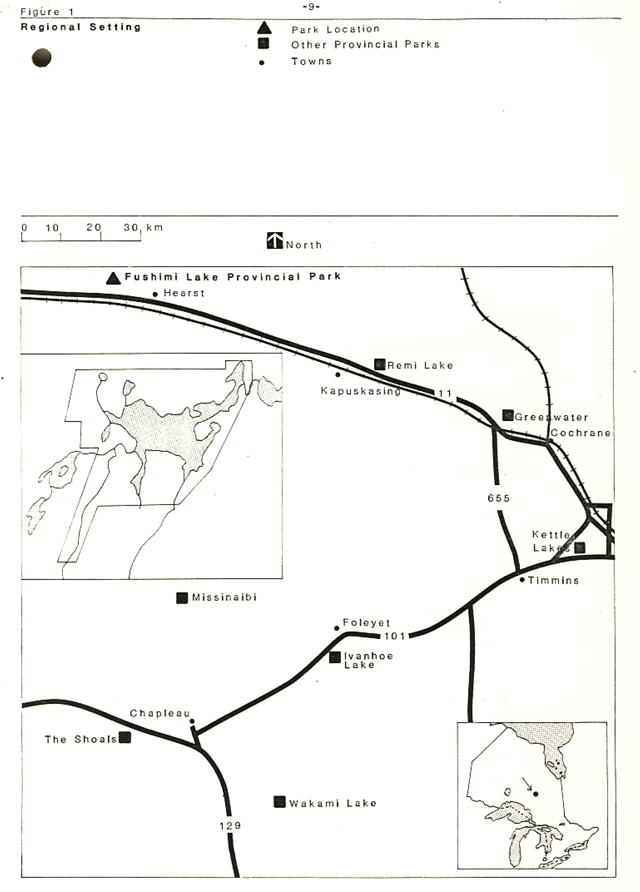
Figure 2: Park area
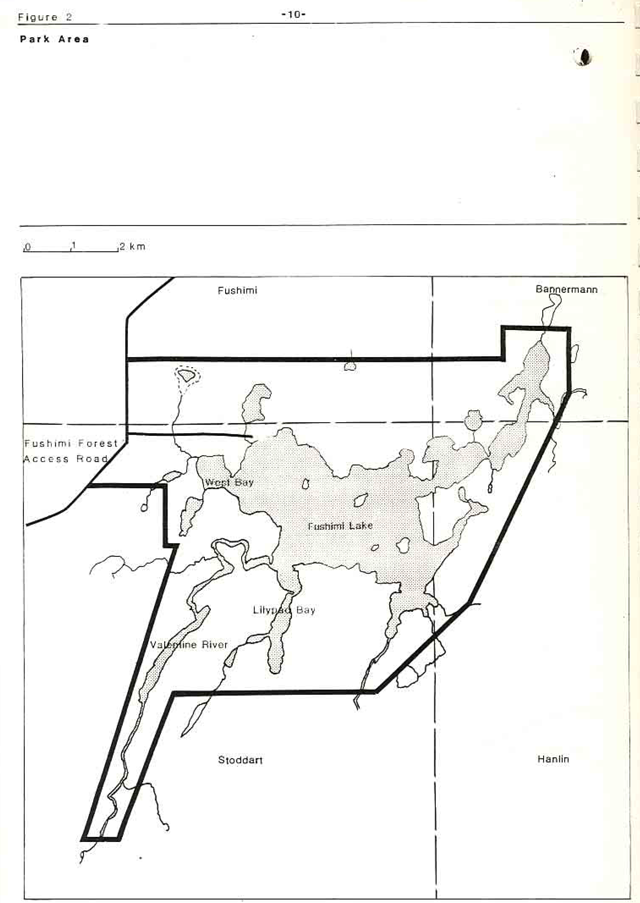
Figure 3: Zoning

Figure 4: Existing development
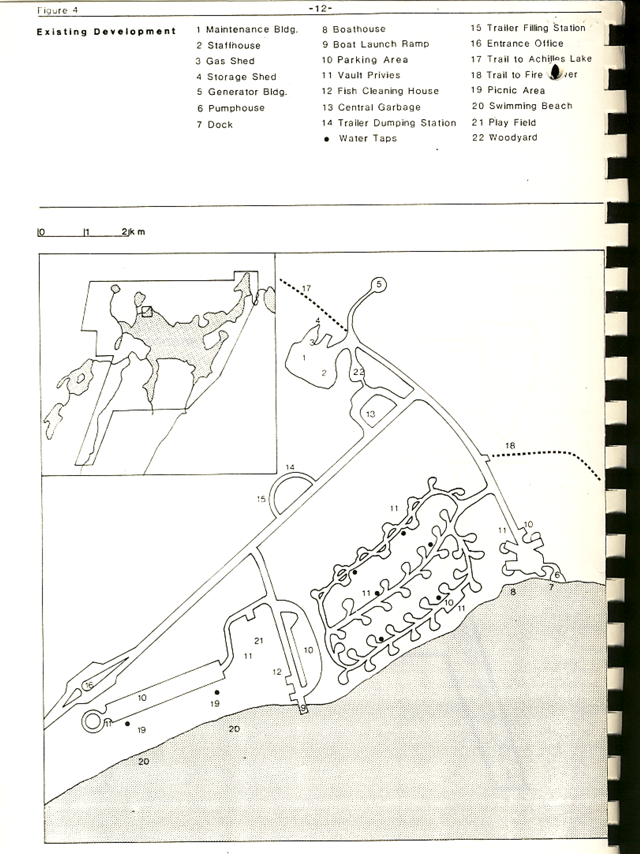
Figure 5: Significant features
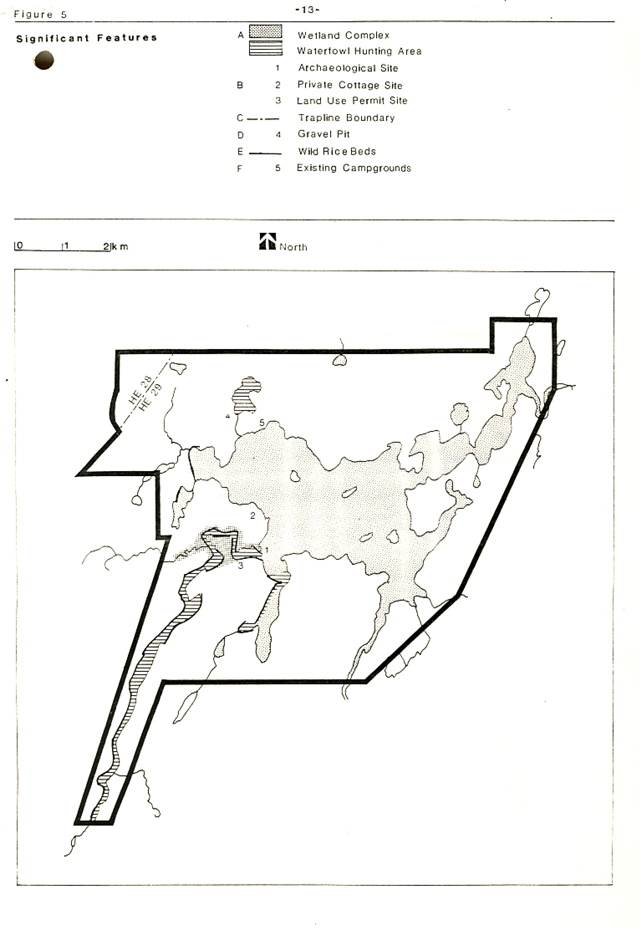
Figure 6: Potential development
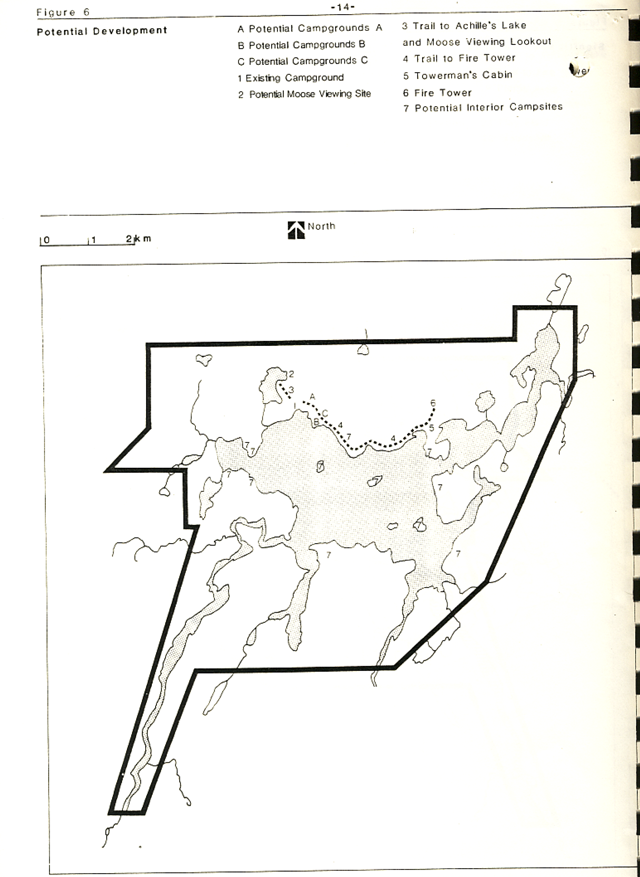
References
Ontario Ministry of Natural Resources. Fushimi Lake Provincial Park Background Information, (unpublished), Hearst District Office.
Ontario Ministry of Natural Resources. Northern Region Parks System Visitor Services Plan, 1978, Regional Office, Cochrane.
Ontario Ministry of Natural Resources. Ontario Provincial Parks Landscape Design Principles and Guidelines, Outdoor Recreation Group, Toronto 1977.
Ontario Ministry of Natural Resources. Ontario Provincial Parks Planning and Management Policies, Outdoor Recreation Group, Toronto, 1978.